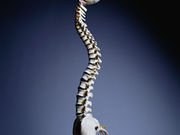Significantly different prevalence for quantitative morphometry, algorithm based qualitative methods
MONDAY, July 24, 2017 (HealthDay News) — The prevalence of vertebral fracture varies for different methods of radiological assessment, according to a study published online July 18 in the Journal of Bone and Mineral Research.
Ling Oei, M.D., Ph.D., from the Erasmus Medical Center in Rotterdam, Netherlands, and colleagues assessed cross-sectional radiographs for 7,582 participants aged 45 to 95 years to examine statistical measures of agreement and prevalence of osteoporotic vertebral fractures. The authors compared the quantitative morphometry (QM) method, which evaluates vertebral height loss that affects vertebral shape, and the algorithm based qualitative (ABQ) method, which judges endplate integrity and includes guidelines for the differentiation of vertebral fracture and non-fracture deformities.
The researchers found that the prevalence was 14.2 and 4.0 percent with QM and ABQ, respectively. Inter-method agreement was 0.24 and 0.74 according to the kappa statistic and Prevalence Adjusted Bias Adjusted Kappa (PABAK), respectively. Between-method agreement was highest for females (κ = 0.31; PABAK = 0.78), participants aged older than 80 years (κ = 0.40; PABAK = 0.66), and at the L1 level (κ = 0.40, PABAK = 0.97). Most fractures were found at the thoraco-lumbar junction (T12 to L1), followed by the T7 to T8 level with ABQ, while most deformities were in the mid (T7 to T8) and lower thoracic spine (T11 to T12) with QM; similar numbers of fractures were seen in both peaks. Agreement between methods was increased by excluding mild deformities (κ = 0.24 to 0.36; PABAK = 0.74 to 0.86) and re-examining mild deformities based on endplate depression (κ = 0.24 to 0.40; PABAK = 0.74 to 0.86).
“Vertebral fracture prevalence differs significantly between QM and ABQ; reexamining QM mild deformities based on endplate depression would increase the agreement between methods,” the authors write.
Copyright © 2017 HealthDay. All rights reserved.








